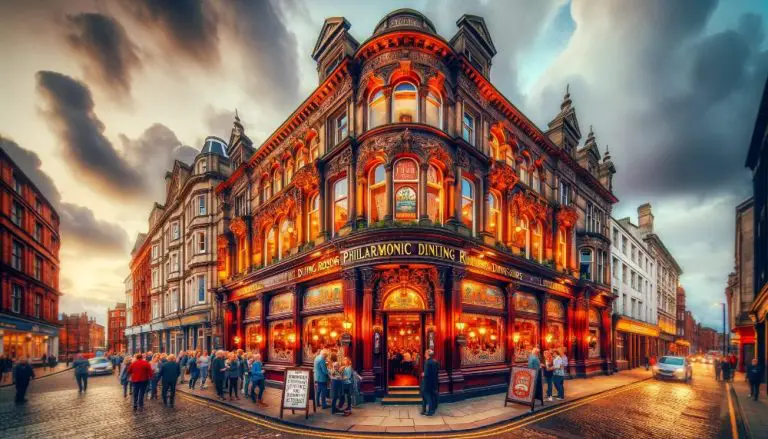Woolton Hall, Liverpool – the History Behind this Hidden Gem

Woolton Hall in Liverpool is a historic mansion nestled in the charming Woolton Village. This magnificent Grade I listed English country house is an architectural masterpiece, renowned for its grandeur and rich heritage. A visit to Woolton Hall is a journey through time, allowing you to immerse yourself in the opulence of a bygone era.
Key Takeaways:
- Woolton Hall is a historic mansion located in Woolton Village, Liverpool.
- It is a Grade I listed English country house known for its grand architecture.
- Woolton Hall is a popular visitor attraction and heritage site.
- Efforts are being made to preserve and protect Woolton Hall for future generations.
A Stately Home with Rich History
Woolton Hall, a historic mansion in Liverpool, England, boasts a rich history as a stately home. It was once the residence of two remarkable individuals, the Earl of Sefton and Liverpool shipowner Frederick Richards Leyland. These notable figures lived within its grand walls, and their stories became intertwined with the legacy of this magnificent hall.
Today, Woolton Hall stands as a testament to their extraordinary lives and invites visitors to step into the past and explore its grandeur. This historic mansion holds a key place in the history of Liverpool and continues to captivate all who set foot on its grounds.
Architectural Gem Restored by Robert Adam
Robert Adam, an influential architect, meticulously restored Woolton Hall in 1772, showcasing his mastery of design and architectural style. The hallmark of Woolton Hall’s grandeur lies in its Classical architectural style, making it the finest example of Adam’s work in the North of England. The hall’s restoration highlights Adam’s ability to create harmonious spaces that exude elegance and magnificence.
A Building at Immediate Risk
In 2021, Woolton Hall, a historic mansion in Liverpool, was declared at “immediate risk” by Historic England. The building, despite its status as a Grade I listed heritage site, is facing significant challenges with degradation and requires extensive restoration to preserve its historic fabric.
Historic England, the government body responsible for the preservation of England’s historic environment, has recognized the urgent need to protect Woolton Hall from further deterioration. The building’s architectural significance and historical importance make its restoration a critical priority.
Without immediate attention and intervention, Woolton Hall could face irreversible damage and potentially be lost forever. Its grandeur and cultural value would be lost to future generations.
Preserving History for Future Generations
The declaration of Woolton Hall being at “immediate risk” highlights the importance of securing its future. The building’s rich history and architectural beauty make it a valuable cultural asset, not only for Liverpool but for the entire United Kingdom.
Preserving Woolton Hall is not only about maintaining the physical structure; it is about safeguarding a piece of history that tells the story of the region and its people. The hall stands as a testament to the past, connecting us to those who came before us and providing insight into our collective heritage.
Historic England plays a vital role in protecting our nation’s historic sites, and their recognition of Woolton Hall’s immediate risk underscores the urgency of action. It serves as a reminder that these architectural gems are fragile and require our collective commitment to ensure their survival.
The challenge now lies in finding the resources and expertise needed to carry out the necessary restoration work. Funding, partnerships, and community engagement will all play critical roles in securing Woolton Hall’s future for the enjoyment and education of generations to come.
Building a Sustainable Future
Preserving Woolton Hall is not just about addressing its current state of decay but also about creating a sustainable future. By implementing conservation practices and engaging in ongoing maintenance, we can ensure the long-term survival of this historic building.
Woolton Hall’s restoration presents an opportunity to showcase the importance of sustainable historic preservation. By using environmentally friendly materials, energy-efficient systems, and promoting responsible visitor management, we can maintain the building’s integrity while minimizing its impact on the environment.
Moreover, by promoting access and inclusivity, we can ensure that Woolton Hall remains a vibrant and accessible cultural destination for all members of the community and visitors alike.
The restoration and preservation of Woolton Hall will require collaboration, dedication, and a shared vision from various stakeholders. By working together, we can protect this valuable heritage site and secure its place in the cultural landscape of Liverpool and the United Kingdom.
A Building with a Colorful Past
Woolton Hall has a truly colorful past. While it now stands as a symbol of architectural beauty and heritage, its journey has been filled with twists and turns. At one point, this grand building served as a school for many years. However, as time went on, it faced the threat of demolition, leaving its fate uncertain.
I’m glad to say, however, that Woolton Hall’s story did not end there. A successful campaign emerged to save this historic mansion, and in 1982, it was rightfully designated as a Grade I listed building. This recognition not only preserved its physical structure but also acknowledged its importance as a cultural and historical asset.
Since that landmark moment, ongoing efforts have been made to restore and preserve Woolton Hall’s architectural beauty. Restoration projects have focused on both the interior and exterior, ensuring that the grandeur of this iconic landmark remains intact. The commitment to restoration not only honors the building’s storied past but also allows visitors to experience a slice of history firsthand.
Today, Woolton Hall stands as a testament to the dedication of those who have fought to preserve its rich heritage. It serves as a valuable reminder of the important role that historic buildings play in shaping our communities, connecting us to our past, and inspiring future generations.
Ownership and Evolution
Woolton Hall, with its fascinating history, has seen a succession of owners over the years, each leaving their mark on the building. From the influential Molyneux family to the prestigious Ashton family, and later the renowned Frederick Richards Leyland, this historic mansion has been associated with prominent figures throughout its existence.
One noteworthy owner was the McGuffie family, esteemed shipowners who transformed Woolton Hall into a charming hotel. The hall subsequently served as a school, representing the evolution of its purpose over time.
Today, Woolton Hall stands as a testament to the changing ownership and the varied roles it has fulfilled in different periods. Let’s delve deeper into the individuals who have shaped its history.
Exquisite Interior and Exterior
The interior of Woolton Hall is adorned with exquisite details. From the marble flooring and oak fireplaces to the paintings and tapestries, every element showcases the grandeur and beauty of the building.
The exterior features a classical architectural style, with stone construction and intricate details designed by Robert Adam.
Interior: A Feast for the Eyes
The interior of Woolton Hall captivates visitors with its opulent design and attention to detail. The halls are lined with luxurious marble flooring, exuding elegance and grandeur.
The highlight of the interior is the collection of oak fireplaces, meticulously carved with ornate details. These fireplaces not only served as a source of warmth but also as stunning focal points, adding character and charm to the various rooms within the mansion.
“The interior of Woolton Hall is a true masterpiece, showcasing the skill and craftsmanship of the architects and artisans involved in its creation.”
The walls are adorned with a collection of paintings, each telling a unique story and adding to the historical ambiance of the hall. The tapestries that hang throughout the mansion depict scenes of grandeur and splendor, providing a glimpse into the past.
Exterior: A Testament to Classical Architecture
The exterior of Woolton Hall is a sight to behold, showcasing the mastery of Robert Adam’s architectural design. The building features a symmetrical layout, with a central entrance and wings on either side, giving it a balanced and harmonious appearance.
The classical architectural style is evident in the stone construction, which exudes a sense of timeless beauty and durability. Elaborate details such as columns, cornices, and pediments further enhance the elegance of the exterior, creating a visually stunning facade.
| Feature | Description |
|---|---|
| Stone Construction | The use of stone in the construction of Woolton Hall not only adds to its aesthetic appeal but also ensures its longevity and durability. |
| Symmetrical Layout | Woolton Hall’s symmetrical layout creates a sense of balance and harmony, contributing to its classical architectural style. |
| Elaborate Details | The intricate details found in the columns, cornices, and pediments showcase the skill and craftsmanship of Robert Adam and his team of artisans. |
Hidden Treasures and Artistic Splendor
One of the highlights of Woolton Hall is its impressive art collection, which includes a diverse range of paintings and tapestries. These artistic treasures add to the allure of the historic mansion, providing visitors with a glimpse into the rich cultural heritage that resides within its walls.
Tapestry Room: A Hidden Treasure
The tapestry room at Woolton Hall is a true hidden treasure. As you step into this breathtaking space, you are welcomed by the sight of exquisite Flemish paintings and sparkling glass chandeliers. The intricate tapestries that adorn the walls tell stories of bygone eras and add a touch of elegance and grandeur to the room.
While exploring the halls of Woolton Hall, you’ll come across replica paintings that depict former residents and their lives in intricate detail. These replicas provide a glimpse into the past, allowing visitors to connect with the history of the mansion and the people who once called it home.
The original paintings from Woolton Hall’s collection have found homes in prestigious art institutions, such as the renowned Walker Art Gallery. These masterpieces are a testament to the artistic significance of the collection and reflect the cultural value that Woolton Hall holds.
| Art Collection Highlights | Location |
|---|---|
| Flemish paintings | Tapestry Room |
| Replica paintings of former residents | Halls |
| Original paintings | Walker Art Gallery |
The art collection at Woolton Hall is a testament to the mansion’s rich cultural heritage. From the intricate tapestries in the hidden treasure of the tapestry room to the replicas and original paintings throughout the halls, every piece adds to the artistic splendor of this historic mansion.
The Future of Woolton Hall
Despite being a Grade I listed building, Woolton Hall has faced challenges in recent years. The building was added to Historic England’s “Heritage at Risk Register” as a category A site, indicating that it is at immediate risk of further deterioration or loss of fabric. Efforts are being made to secure its future and ensure its preservation for generations to come.
Visitor Experience and Cultural Significance
In the heart of Liverpool lies Woolton Hall, a captivating visitor attraction and heritage site that offers a truly immersive cultural visit. With its grand architecture and deep-rooted history, this iconic landmark is a must-visit destination for those seeking an enriching experience.
When you step inside Woolton Hall, you’re transported to a bygone era, where every room tells a story of its own. Explore the splendid interior, adorned with exquisite details that reflect the hall’s opulent past. Marvel at the marble flooring, oak fireplaces, and captivating artwork that adorn the walls.
As you wander through the corridors, you’ll discover a remarkable art collection that showcases both local and international talent. The tapestry room, in particular, is a hidden gem, adorned with Flemish paintings and magnificent glass chandeliers.
Beyond its tangible beauty, Woolton Hall holds immense cultural significance. This iconic site has witnessed the changing tides of Liverpool’s history, serving as a testament to the city’s rich heritage. The lives of notable figures who once called Woolton Hall home are woven into the very fabric of the building.
Immerse Yourself in the Past
Immerse yourself in the past as you delve into the captivating stories surrounding Woolton Hall. Learn about the aristocrats, shipowners, and other fascinating characters who have left their mark on this historic mansion. From the Earl of Sefton to Frederick Richards Leyland, their legacies are etched into the walls of Woolton Hall.
Imagine the grandeur of social gatherings held within these walls, with esteemed guests mingling in the beautifully manicured gardens. Feel the weight of history as you walk the same halls that once echoed with laughter, conversation, and the footsteps of those who shaped Liverpool’s identity.
Preserving the Past for Future Generations
Woolton Hall’s cultural significance extends beyond its grandeur; it represents a collective effort to preserve history for future generations. Dedicated individuals and organizations have worked tirelessly to maintain and restore this architectural masterpiece, ensuring its authenticity remains intact.
Table (name it whatever you want, such as “Woolton Hall Highlights”):
| Year | Significant Event |
|---|---|
| 1704 | Construction of Woolton Hall |
| 1772 | Extensive renovation by Robert Adam |
| 1982 | Designated as a Grade I listed building |
| 2021 | Declared at “immediate risk” by Historic England |
Despite its current status on Historic England’s “Heritage at Risk Register,” efforts are underway to secure a sustainable future for Woolton Hall. By visiting this cherished heritage site, you are not only immersing yourself in history and culture but also contributing to its ongoing preservation.
Plan your visit to Woolton Hall and embark on a journey through time. Lose yourself in the grandeur of this architectural masterpiece and discover the cultural significance that continues to captivate visitors from near and far. Experience the allure of Woolton Hall as it stands as a testimony to Liverpool’s vibrant past and enduring legacy.
Conclusion
Woolton Hall, a historic mansion nestled in the heart of Liverpool, is a true marvel of architectural beauty. Its grand design, steeped in rich history, captivates the imagination of visitors from both near and far. Despite the challenges it faces and the risk it carries, dedicated efforts are underway to safeguard the splendor of this remarkable landmark, ensuring its place as a cherished visitor attraction.
A visit to Woolton Hall is a journey through time, offering a glimpse into the past, present, and future. As you wander through its hallowed halls, you can’t help but be awestruck by its grandeur and the cultural significance it holds. Each nook and cranny of this historic mansion whispers tales of the lives it has witnessed and the stories it has been part of, weaving together a narrative that transcends generations.
Woolton Hall stands as a testament to the enduring legacy of architectural excellence. Its rich history and remarkable beauty continue to inspire and fascinate. Whether you are an architecture enthusiast, a history buff, or simply seeking a cultural experience, a visit to Woolton Hall promises to be an enchanting and enlightening journey. Discover the architectural marvels of Liverpool, immerse yourself in the heritage of Woolton Hall, and let the echoes of the past guide your footsteps.
FAQ
What is Woolton Hall?
Woolton Hall is a historic mansion located in Woolton, a suburb of Liverpool, England. It is a grand architectural marvel and is listed as a Grade I English country house.
Who were some notable residents of Woolton Hall?
Woolton Hall has been the residence of the Earl of Sefton, Liverpool shipowner Frederick Richards Leyland, and others who have left their mark on the building.
Who renovated Woolton Hall?
Woolton Hall was extensively renovated by the influential architect Robert Adam in 1772, showcasing his mastery of design and the Classical architectural style.
Why is Woolton Hall at immediate risk?
Woolton Hall has been added to Historic England’s “Heritage at Risk Register” as a category A site, indicating it is at immediate risk of further deterioration or loss of fabric.
What is the history of Woolton Hall?
Woolton Hall served as a school before being saved from demolition and designated as a Grade I listed building. Efforts have been made to restore and preserve its architectural beauty.
Who were the previous owners of Woolton Hall?
Woolton Hall has had a series of owners, including the Molyneux family, the Ashton family, Frederick Richards Leyland, and the McGuffies, a family of shipowners who converted the hall into a hotel.
What is the interior and exterior like?
The interior of Woolton Hall is adorned with exquisite details, including marble flooring, oak fireplaces, paintings, and tapestries. The exterior showcases Classical architectural style and intricate details designed by Robert Adam.
What art collection does Woolton Hall have?
Woolton Hall houses an impressive art collection, including paintings and tapestries. The tapestry room is a hidden treasure adorned with Flemish paintings and glass chandeliers.
What is the future of Woolton Hall?
Woolton Hall is currently at risk but efforts are being made to secure its future and preserve its beauty for generations to come.
Why is Woolton Hall a popular visitor attraction?
Woolton Hall’s grand architecture, rich history, and cultural significance make it a popular visitor attraction and heritage site in Liverpool.
Source Links
- https://en.wikipedia.org/wiki/Woolton_Hall
- https://wollatonhall.org.uk/
- https://www.studentcrowd.com/hall-l1004037-s1044523-woolton-hall-the_university_of_manchester-manchester
- The History Behind Liverpool’s You’ll Never Walk Along - February 16, 2024
- The History of Everton FC - February 16, 2024
- The History of Liverpool FC - February 16, 2024




